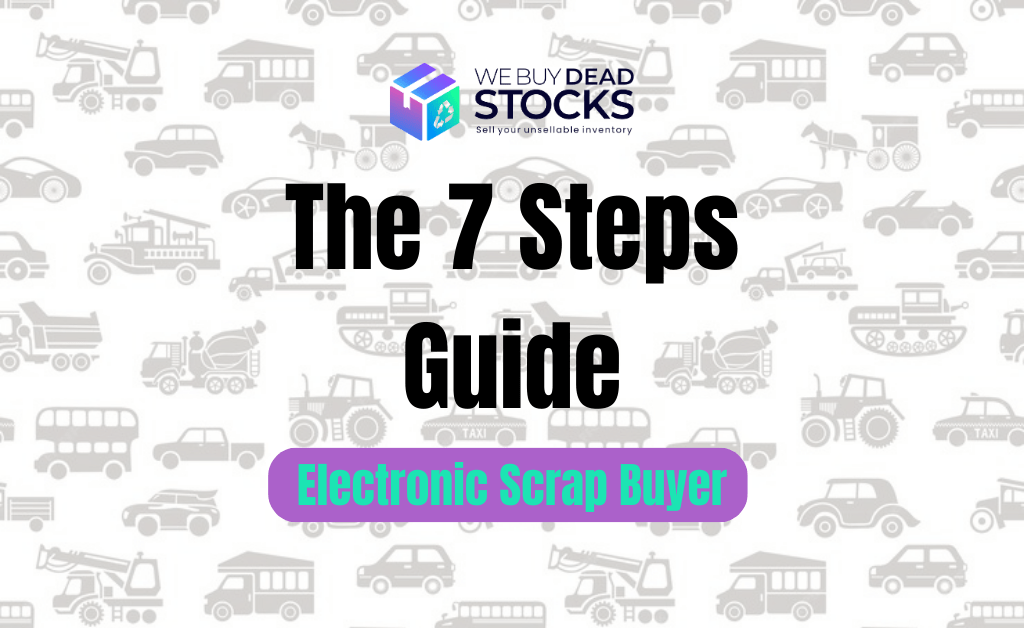As technology advances at an unprecedented pace, the need for responsible disposal and recycling of electronic waste has become more critical than ever. In this comprehensive seven-step guide, we will navigate through key considerations that will empower you to make an informed decision when selecting an electronic scrap buyer.
Step 1: Assess Your Electronic Scrap
- Know Your Electronic Junk
Unearth the treasures hidden in your old gadgets by identifying the types of electronic scrap you have. Electronics come in various forms, such as outdated smartphones, obsolete laptops, and unused gadgets. Take a moment to categorise and understand the diversity of your electronic possessions and know what goes in for metal waste recycling.
- Count and Inspect
Take a closer look at the quantity and condition of your raw material. Count each item and assess its overall state. Are there broken screens, missing buttons, or signs of wear and tear? Understanding the condition of your electronics will help you make informed decisions on how to proceed.
- Find the Good Stuff
Dig deeper into your electronic stash to uncover any hidden gems. Valuable components or materials might include precious metals, functional circuit boards, or rare elements. Raw material can be salvaged and potentially reused or sold, adding a financial incentive to your electronic scrap adventure.
Step 2: Research Potential Electronic Scrap Buyers
- Utilising Online Resources and Directories
Take advantage of online platforms and directories dedicated to electronic scrap buyers. Browse through various resources to compile a list of potential buyers.
- Seeking Recommendations from Industry Professionals and Peers
Tap into the knowledge of industry professionals and seek recommendations from peers who have experience with metal scrap recycling. Their insights can guide you toward trustworthy buyers and help you avoid potential pitfalls in the process.
- Considering Local and Global Electronic Scrap Buyers
Evaluate whether local or global buyers better suit your needs. Local electronic scrap buyers may offer convenience, while global buyers could provide a broader market and potentially better prices. Consider factors like shipping costs, reliability, and environmental policies when making this decision.
Step 3: Evaluate Reputation and Credentials
- Checking the Buyer’s Reputation Within the Industry
Investigate the buyer’s standing within the electronic scrap industry. Seek out reviews from other sellers, testimonials, and any available industry recognition. A positive reputation suggests reliability and professionalism, making it more likely that your transaction will be handled with care.
- Verifying Certifications and Compliance with Environmental Standards
Confirm that the buyer holds relevant certifications and complies with environmental standards. Look for certifications such as R2 (Responsible Recycling) or e-Stewards, which demonstrate a commitment to environmentally sustainable practices. Ensuring compliance with these standards safeguards against improper disposal and environmental harm.
- Assessing the Buyer’s Track Record and Experience
Experience matters in the electronic scrap recycling business. Assess how long the buyer has been in operation and examine their track record. A buyer with a proven history of successful transactions and positive relationships with sellers is more likely to provide a reliable and efficient service.
Step 4: Analyse Recycling Practices
- Investigating the Buyer’s Recycling Methods and Technologies
Delve into the recycling practices of potential buyers. Research their methods and technologies to ensure they align with environmentally friendly standards. Opt for buyers who employ advanced recycling techniques, minimising the environmental impact of electronic waste.
- Ensuring Compliance with Environmental Regulations
Prioritise buyers who adhere to stringent environmental regulations. Verify their compliance with local and international laws governing electronic waste disposal. Choosing a responsible buyer not only safeguards the environment but also protects you from potential legal complications.
- Requesting Quotes from Multiple Electronic Scrap Buyers
Cast a wide net by requesting quotes from various electronic scrap buyers. This step allows you to compare offers and make an informed decision. Provide detailed information about your electronic scrap to ensure accurate quotes that reflect the true value of your items.
Step 5: Examine Pricing and Terms
- Understanding Pricing Structures and Potential Hidden Fees
Scrutinise the pricing structures provided by potential buyers. Understand the breakdown of costs and inquire about any hidden fees. Transparency in pricing ensures that you receive fair compensation for your electronic scrap without unexpected deductions.
- Negotiating Favourable Terms and Conditions
Don’t hesitate to negotiate with potential buyers. Discuss terms and conditions that align with your preferences and needs. Whether it’s payment timelines, shipping arrangements, or additional services, negotiating ensures a mutually beneficial agreement.
Step 6: Consider Customer Reviews and Testimonials
- Scouring Online Platforms for Reviews
Dive into online platforms, forums, and review sites where individuals share their experiences with electronic scrap buyers. Pay attention to both positive and negative reviews to gain a comprehensive understanding of a buyer’s reputation.
- Seeking Feedback from Peers and Industry Experts
Don’t hesitate to seek feedback from your peers and industry experts. Personal recommendations can provide valuable insights into the reliability, professionalism, and overall satisfaction of working with a particular electronic scrap buyer.
- Analysing Testimonials on the Buyer’s Website
Explore the buyer’s official website for testimonials from previous clients. Testimonials often showcase success stories and can offer a glimpse into the buyer’s commitment to customer satisfaction. Look for patterns in the feedback to identify consistent strengths or potential concerns.
- Considering Red Flags and Warning Signs
Be vigilant for red flags or warning signs mentioned in reviews. Common issues such as delayed payments, poor communication, or environmental irresponsibility should not be taken lightly. Consequently, a thorough understanding of others’ experiences can help you avoid potential pitfalls.\
Step 7: Make an Informed Decision
Create a list of pros and cons for each potential buyer based on your research. Consider factors such as their recycling practices, compliance with regulations, pricing, and customer feedback. Hence, this comparative analysis will help you visualise the strengths and weaknesses of each option.
Look beyond the numbers and consider the overall value each buyer brings to the table. Factor in their reputation in the industry, the transparency of their pricing structures, and their commitment to environmentally responsible practices. The ideal buyer should offer a comprehensive package that aligns with your values.
Armed with the knowledge gathered through your research, make a well-informed decision. Choose the electronic scrap buyer that not only offers competitive pricing but also aligns with your sustainability goals and provides a positive overall experience. Trust your judgement and feel confident in your choice.





